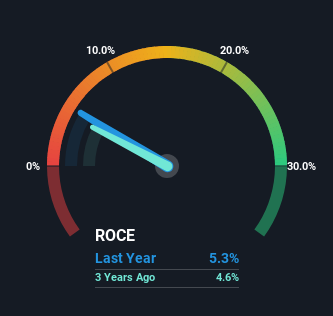Returns At Consolidated Edison (NYSE:ED) Appear To Be Weighed Down
What trends should we look for it we want to identify stocks that can multiply in value over the long term? In a perfect world, we'd like to see a company investing more capital into its business and ideally the returns earned from that capital are also increasing. Basically this means that a company has profitable initiatives that it can continue to reinvest in, which is a trait of a compounding machine. Although, when we looked at Consolidated Edison (NYSE:ED), it didn't seem to tick all of these boxes.
Understanding Return On Capital Employed (ROCE)
Just to clarify if you're unsure, ROCE is a metric for evaluating how much pre-tax income (in percentage terms) a company earns on the capital invested in its business. The formula for this calculation on Consolidated Edison is:
Return on Capital Employed = Earnings Before Interest and Tax (EBIT) ÷ (Total Assets - Current Liabilities)
0.053 = US$3.2b ÷ (US$67b - US$6.2b) (Based on the trailing twelve months to March 2024).
Thus, Consolidated Edison has an ROCE of 5.3%. On its own that's a low return on capital but it's in line with the industry's average returns of 5.0%.
View our latest analysis for Consolidated Edison
Above you can see how the current ROCE for Consolidated Edison compares to its prior returns on capital, but there's only so much you can tell from the past. If you'd like, you can check out the forecasts from the analysts covering Consolidated Edison for free.
The Trend Of ROCE
In terms of Consolidated Edison's historical ROCE trend, it doesn't exactly demand attention. The company has consistently earned 5.3% for the last five years, and the capital employed within the business has risen 24% in that time. Given the company has increased the amount of capital employed, it appears the investments that have been made simply don't provide a high return on capital.
The Bottom Line
As we've seen above, Consolidated Edison's returns on capital haven't increased but it is reinvesting in the business. And with the stock having returned a mere 24% in the last five years to shareholders, you could argue that they're aware of these lackluster trends. As a result, if you're hunting for a multi-bagger, we think you'd have more luck elsewhere.
Consolidated Edison does have some risks, we noticed 2 warning signs (and 1 which is a bit concerning) we think you should know about.
If you want to search for solid companies with great earnings, check out this free list of companies with good balance sheets and impressive returns on equity.
Have feedback on this article? Concerned about the content? Get in touch with us directly. Alternatively, email editorial-team (at) simplywallst.com.
This article by Simply Wall St is general in nature. We provide commentary based on historical data and analyst forecasts only using an unbiased methodology and our articles are not intended to be financial advice. It does not constitute a recommendation to buy or sell any stock, and does not take account of your objectives, or your financial situation. We aim to bring you long-term focused analysis driven by fundamental data. Note that our analysis may not factor in the latest price-sensitive company announcements or qualitative material. Simply Wall St has no position in any stocks mentioned.
Have feedback on this article? Concerned about the content? Get in touch with us directly. Alternatively, email editorial-team@simplywallst.com

 Yahoo Finance
Yahoo Finance 
